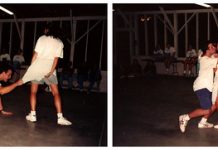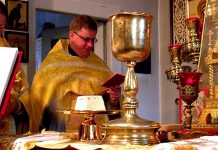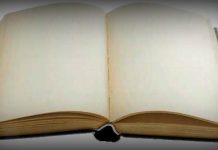
We serve a loving and supernatural God, Who longs to express His grace and power through us in our everyday lives.
Last week I shared some reasons why we can pray for physical healing, and today I want to share 3 simple ways that you can put it into practice.
When we start out, it can be helpful to become familiar with a few different methods of praying. It is a bit like having access to a toolkit. We can then use whichever method suits the situation—or pray as the Holy Spirit leads us.
When you look at how Jesus healed people in the Gospels, you see many different ways that it took place.
So when we pray, it is not about a formula, although you might find one way of praying for healing that suits you.
Contrary to what some people may try and tell you, there is no one best method to pray for healing.
If there was one superior method, then those healing ministries in the world to day that are getting the most results would all be using one method. But they are not—they all have different expressions of ministry!
Here are three different ways that you can pray for healing. I call them Petition (Asking) Prayer, Power Prayer, and Pastoral (Caring) Prayer.
We petition God when we simply ask Him to do something—in this case to bring healing—in Jesus’ Name.
Petition is not inferior to other types of prayer—asking is powerful, and is the privilege of sons and daughters. (Matt 7:7-11, John 14:13-14)
Making requests of God should be done with thanksgiving—we pray with the confidence that He hears us, and has already provided the answer to our prayer. (Phil 4:6)
We see petition happening in the Bible when people came to Jesus asking for healing on behalf of themselves and others.
Petition prayer is a powerful witness to non-Christians because it demonstrates our relationship with God.
Power Prayer is short, brief and to the point, rather like a ‘laser beam’ of focused prayer or command, using the Name of Jesus.
In Power Prayer, we exercise the authority God has given to us over sickness. This includes:
A. Praying using the authority of Jesus’ Name (Acts 4:10,30; John 14:12-14)
B. Praying or declaring scripture
God’s word has authority. Some scriptures we can pray include 1 Peter 2:24, Ex 15:26, Ps 107:20
C. Speaking a word of command to the sickness (Ps 107:20)
Jesus frequently used a word of command or pronouncement of healing. (Luke 8:54, John 5:8, Matt 12:13)
Peter primarily used the spoken word to bring healing in his ministry. (Acts 3:6, 9:34, 9:40)
In pastoral care prayer, we aim specific prayer at caring for the person, not only for healing, but also for issues related to the illness.
The power of Pastoral Prayer is that we are praying specifically. It lets the person know that God cares and we care about their whole life related to that issue. (Gal 6:2, Rom 12:12)
Some things we can pray for include:
- Healing and Divine intervention
- Pray concerning specific symptoms as well as the underlying cause of the sickness
- Other family members affected by the need expressed
- Key events such as medical appointments, operations, and so on
- The medical skill of doctors and other professionals
- Other logistics relating to the illness—such as finance, help and transport
- Any emotional responses to the situation—e.g. fear, trauma or anxiety
I like to pray for a fresh infilling of the Holy Spirit for Christians who are in difficult times or require healing. They may have had a lot of emotion, or pain to deal with and can feel depleted emotionally, mentally, physically and spiritually.
Here are some further thoughts about prayer for healing:
Table of contents
Repeated Prayer
Repeated prayer show the people that we care enough to journey the distance with them. And God may use the power of recurring prayer in the process of healing. Jesus prayed more than once for a blind man, who was healed gradually. (Mark 8:22-26)
Two Points of Connection
a. Laying on hands
Laying on of hands was one of many methods that Jesus used to minister healing to people. (Luke 4:40)
Paul mostly used the laying on of hands and physical impartation to heal. (Acts 20:10, 19:11-12, 28:8)
The benefits of having a physical point of connection include:
- It can help build faith
- It reminds others and us that we are an agent, or representative of Jesus.
- It is a Biblical means of impartation (releasing the healing power of God through one person to another)
We should always ask people first to ensure they are comfortable with us touching them as we pray.
b. Anointing with oil
Anointing with oil is symbolic. It is recommended for use by leaders in the NT. (James 5:14) Jesus’ disciples also used anointing oil on one occasion in Mark 6:13.
We need to keep in mind that unchurched people do not understand the symbolism of anointing with oil, therefore it is may not always be appropriate.
Finally, important things to remember whilst praying for healing are:
- The basis for our prayer is not our ability, but what Jesus has accomplished on the cross. (1 Peter 2:24)
- Jesus healed people out of compassion. (Matt 14:14) Love is vital to praying for healing as it is in any ministry situation. (1 Cor 13:2-3)
- Never advise people to cease prescribed medications. If they believe they are healed, refer them to their physician for confirmation first.
- Acknowledge the mystery of prolonged or unanswered prayer and never place blame for this on anyone’s ‘lack of faith’.
In 2 Tim 4:20, we learn of a close associate of the Apostle Paul who remained ill. No answers were given. We are called to pray in faith, leaving the outcome up to God.
Other articles in the Healing Series:
7 Reasons Why You Can Pray For Healing
Discover Your Unique Healing Gift
Do you have any further thoughts or questions about the topic of healing? I would love to hear from you. Leave a comment in the comments box below. If the comments box is not visible, click on this link and scroll down.
© Helen Calder 2011 Enliven Blog – Prophetic Teaching
On team with David McCracken Ministries: Prophetic Ministry That Empowers The Church
Did you receive this from a friend? Read more from Enliven Blog or sign to receive our weekly prophetic teaching updates at
www.enlivenpublishing.com
Of all the kinds of healing, physical healing is perhaps the hardest for us to really believe in; it is far easier to believe that prayer can lead to repentance or can change a person psychologically.
Article Tools
- Comment ()
Yet real physical healings take place regularly in the prayer groups I know. Often, a dozen or more occur at conferences when we take the time to pray for the sick.
So if you have the faith that the Lord still heals people as he did two thousand years ago, launch out and learn to pray for the sick. For, although physical healing may stretch your faith (have you ever prayed for a blind person?), it is also the simplest kind of prayer.
The Confidence to Launch Out. To pray for the first time requires courage. I used to feel very foolish, as if I were pretending to be someone special when I knew I was just an ordinary person. Who was I to pretend to be a great healer, to act like Christ? All this was, of course, merely false humility since, as we know, Christ himself instructed his followers to pray for the sick. Sometimes healing requires more courage than faith.
What a joy when we find that God really answers our prayers and heals the people we love! The praise of God spontaneously rises from our hearts. If you have confidence that Jesus might use your prayers to heal the sick, then there are just a few simple steps to learn. They are easy enough to remember; we do not need a graduate degree to learn to pray for physical healing.
I have missionary friends who are teaching the poor people of the barrios of Latin America to pray for the sick, and they report that about eighty percent of these unlettered people are healed or notably improved. There is no one method or technique that always produces results; God wants us to depend on him—not upon a technique. But there are some simple steps that flow out of the very nature of prayer for healing, and these I want to share with you.
Listening. The first step is always to listen in order to find out what to pray for. Just as the first step for a doctor when he meets a patient is to find out what to treat, so we need to find out what we are meant to pray for. A doctor is looking for a right diagnosis. In prayer for healing, we are looking for the right discernment.
We are really listening to two things: to the person who asks for prayer and tells us what seems to be wrong; and to God, who from time to time shares with us the true diagnosis whenever the person isn’t sure what is wrong.
When we listen in this way, the Spirit comes to enlighten us when we are in the dark about what to pray for. To some people this special knowledge seems to come in a very special way in the form of definite mental images or verbal impressions. To many of us, however, the knowledge of what to pray for comes in a very natural way, more like a simple intuition.
We may not be sure whether we are inspired by God or not; we learn by experience to sift out our intuitions and to find what works out in practice. Often, after I have followed what seemed to me a simple intuition about what to pray for, the person I was praying for has told me that I touched on those very things he had not directly mentioned but had hoped that I would pray for. When these intuitions work out time after time, you learn to trust that God is working through them.
In addition to listening to the person, we should also be alert to the promptings of the Spirit who may enlighten us, especially when we don’t know what to pray for. It is not healthy for us to be unduly problem-oriented and symptom-centered. In the abundance of Christ’s health and life, sickness will be overcome, in the brilliance of that light, darkness and ignorance will be dispersed.
Laying on of Hands. In actual praying for the sick, the laying on of hands is a traditional Christian practice: “They will lay their hands on the sick, who will recover” (Mark 16:18). Certainly it is not essential; if you feel that the person you are praying for would be embarrassed or would feel more comfortable if you stay at a distance, then by all means be sensitive to his feelings. But if it does seem right, there are several advantages that explain the New Testament practice of the laying on of hands.
In the first place, there does seem to be a warm current of healing power that often flows from the minister of healing to the sick person. Precisely what happens when we feel this current we are not sure, but it seems like a transfer of life-giving power. Jesus himself experienced this flow of power in such a way that he could sense it:
Now there was a woman suffering from a hemorrhage for twelve years, whom no one had been able to cure. She came up behind him and touched the fringe of his cloak; and the hemorrhage stopped at that instant. Jesus said, “Who touched me?” when they all denied that they had, Peter and his companions said, “Master, it is the crowds round you, pushing.” But Jesus said, “Somebody touched me. I felt that power had gone out from me.” (Luke 8:43-46)
Often we experience this same transfer of power, occasionally like a gentle electric current, but more often like a flow of warmth. Whatever it is, it is often connected with healing. It almost seems like a transfer of life.
Some with the gift of healing talk about “soaking prayer” in which you just soak the person in a prayer of God’s love. In thirty years of praying for the sick, we have discovered that this soaking prayer where we spend time with a person and pray with the laying on of hands helps immeasurably. It’s like God’s radiation treatment: The longer the sickness is held in the force-field of God’s love, the more it shrinks, until it finally disappears.
The Actual Prayer. In praying for the sick person, we can be spontaneous and improvise prayer for healing. We can assume any posture that is most comfortable for us—sitting, kneeling, or standing—where we can best forget ourselves and relax and concentrate on the presence of God. We turn our hearts and minds to the Father, or to Jesus; we know that it is only through their love that anything will happen. After welcoming their presence and praising God, we then turn to the petition itself.
Most ministers of healing suggest that we be specific in our prayer, that we visualize as clearly as possible what we are asking God to heal. For instance, if we are praying for the healing of a broken bone we can ask the Father (or Jesus) to take away every infection, to stimulate the growth of the cells needed to restore the bone, and to fill in any breaks. Such a specific request seems to enliven our own faith, as we see in our imagination what we are praying for. It also stimulates the faith of the sick person as he listens and pictures in his own mind what we are asking God to accomplish in reality. This helps him become more actively involved in the prayer, even if he says nothing.
On the other hand, some of us—that includes me—are by temperament not very good at imagining things; it is much easier to leave the imagination out and just ask God—but in a very specific way—to heal the person.
With Confidence and Thanksgiving. For a long time, there has been a kind of tradition which led most of us to end all our prayers with the phrase, “if it be your will.” The idea behind it, of course, is that we don’t know God’s will, so we don’t have the confidence that everything we ask for will be given us. This is true. Yet, this addition—”if it be your will”—can weaken our prayer if it really means “I don’t believe anything is going to happen.” This is a far cry from the words of Jesus, “Everything you ask and pray for, believe that you have it already, and it will be yours” (Mark 11:24).
If we believe that God answers our prayers always (not always as we think he will, but nevertheless always), we naturally will have a heartfelt desire to thank him. We can thank him even during the prayer: “I thank you, Lord, that even now you are sending you healing love and power into Bill and are answering our prayer.” Our attitude should be that of St. Paul: “There is no need to worry but if there is anything you need, pray for it, asking God for it with prayer and thanksgiving” (Philippians 4:6).
Francis MacNutt is cofounder of Christian Healing Ministries in Jacksonville, Florida. To read an excerpt from his latest book, The Practice of Healing Prayer (The Word Among Us Press), or for more information, visit our bookstore at wau.org.
wau.org










